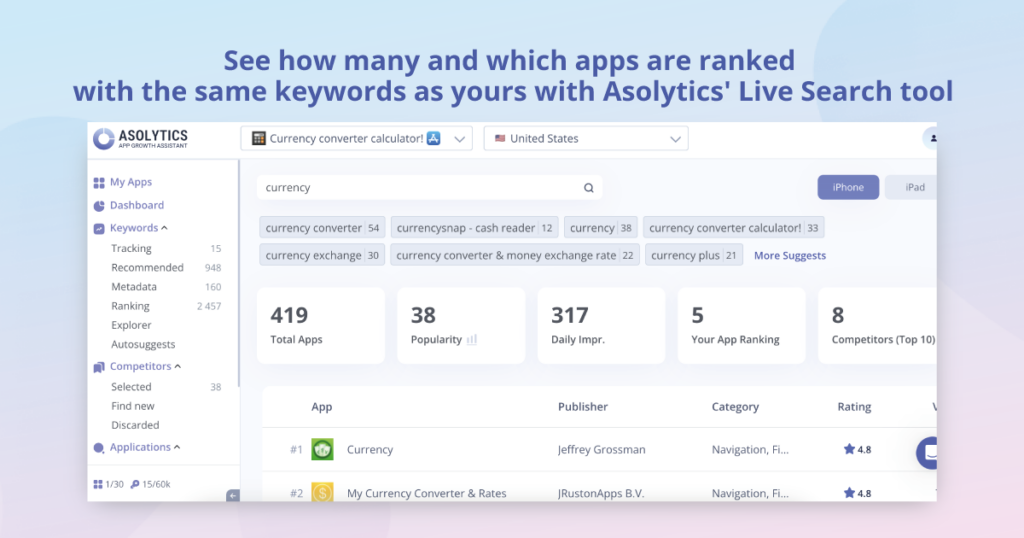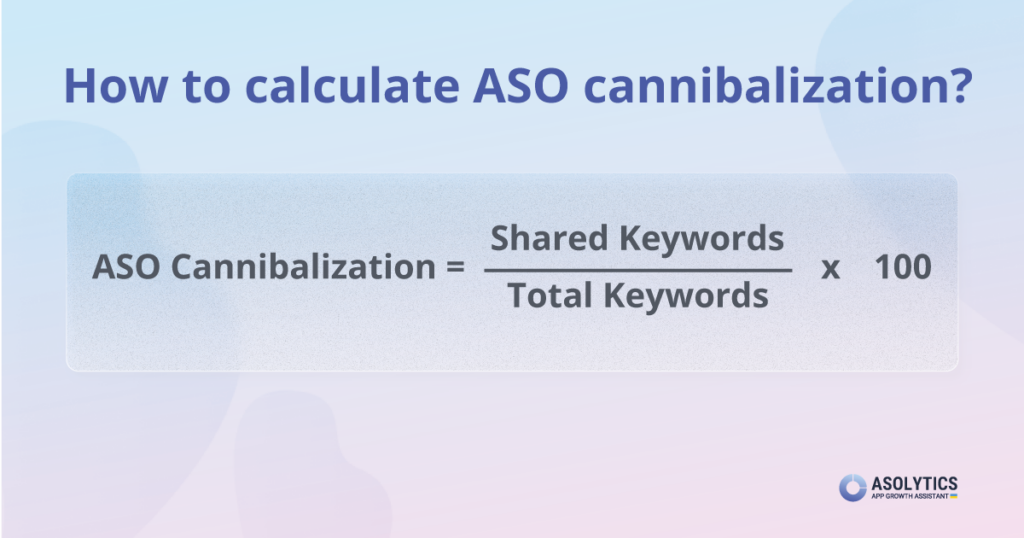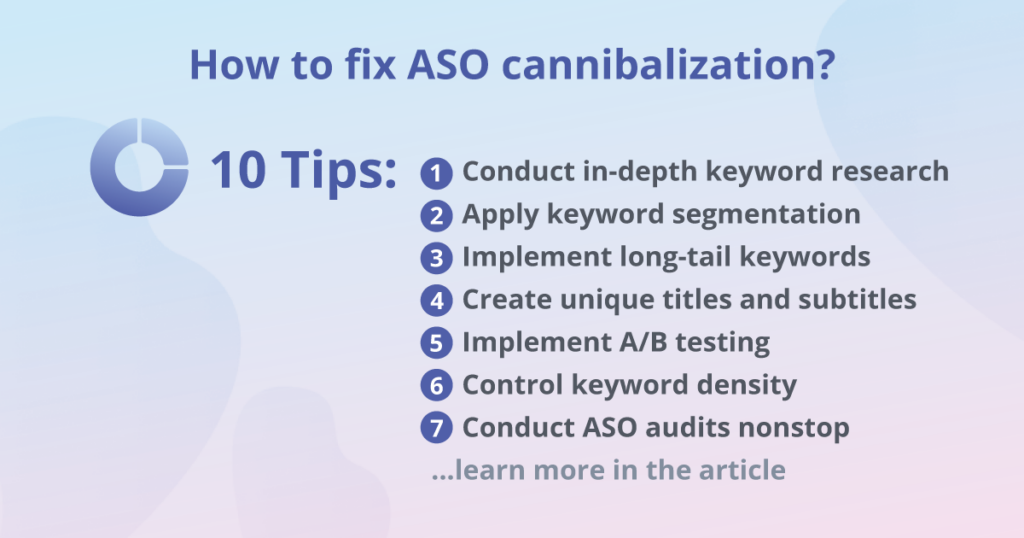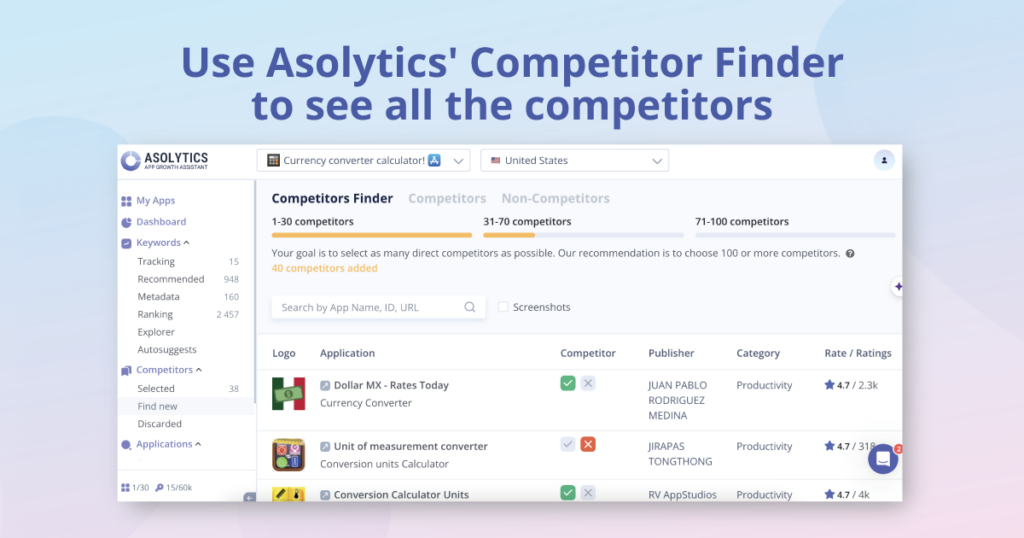You know a thing or two about App Store Optimization (ASO) and the importance of having a solid ASO strategy. But the tricky terms don’t actually end there. Let’s say, when you’re working on your ASO strategy, do you ever consider ASO cannibalization prevention techniques? Do you even realize that cannibalization in marketing is something that can ultimately make your app cease to exist? If you’ve just heard these scary-sounding back-to-the-prehistoric-era terms for the very first time, this article is right up your street.
In this piece, we’ll define ASO keyword cannibalization in simple terms, dwell upon its few perks (yes, they exist!) and multiple drawbacks, as well as provide a treasure trove of vital tips for fixing it. Stay tuned for details.
Table of Contents
What Is ASO Keyword Cannibalization?
Without further ado, ASO cannibalization, often referred to as internal competition, is when your own apps in the app store unintentionally compete and eat each other’s rankings. It’s like hosting a barbecue, and your apps are the starving kiddo guests. They fight over the juiciest keywords, leaving none for the others.
This rivalry of apps does come with a few perks, but in the long run, it diminishes the app’s visibility and reduces organic downloads. Picture it as siblings fighting over the TV remote — everyone loses! To avoid this digital family feud, you need a strategic approach, ensuring your apps complement rather than clash in keyword usage.
It looks like ASO cannibalization has something to do with apps fighting for the remote control to succeed. So, can you protect your app from this mutually devouring competition? Want to know how? Keep reading for some food-for-thought strategies and tips. But let’s start with getting to know the enemy like you know yourself.
ASO Keyword Cannibalization Types: Know Your Enemy
‘If you know the enemy and know yourself, you need not fear the result of a hundred battles.’ We’re sure that Sun Tzu knew nothing about ASO cannibalism, but the basics of battling enemies were his forte. And that’s exactly what we’re after, marketing-wise. Based on this wise thought, before learning to prevent and manage ASO cannibalization, explore the classification of the notion. With that said, there are 3 main types of ASO cannibalization:
- Keyword Cannibalization. This occurs when multiple apps from the same developer or brand compete for the same keywords. It leads to internal competition, lowering visibility and downloads for all apps involved.
- Category Cannibalization. This takes place when multiple apps within the same category target identical keywords. As a result, they can cannibalize each other’s rankings and user base.
- Organic vs. Paid Cannibalization. Balancing organic and paid user acquisition strategies is crucial. Excessive reliance on paid acquisition can lead to organic cannibalization, where organic growth and visibility decline.
Understanding this informative ASO cannibalization classification is vital for maintaining a strong app store presence and maximizing downloads while minimizing internal competition.
The ‘Whys’ Behind ASO Keyword Cannibalisation
Cannibalism in ASO occurs due to various root causes, often stemming from a lack of strategic planning and coordination. Here are the primary factors contributing to ASO cannibalism:
- Keyword Overlap. When multiple apps target the same keywords, they compete for the same user base, leading to cannibalization.
- Similar App Offerings. Developing apps with similar functionalities or features can confuse users and result in internal competition.
- Neglected ASO Strategy. Failing to conduct proper ASO research and optimization can lead to keyword overlap and cannibalization.
- Limited Market Understanding. Insufficient market research and segmentation can result in apps targeting identical user demographics and keywords.
- Lack of Communication. Poor communication within a developer’s team can lead to parallel development efforts, creating apps that unintentionally overlap in their target audience or keywords.
- Changing Strategies. Frequent shifts in ASO strategies without evaluating their impact can lead to conflicting approaches among apps.
- Inconsistent Branding. Apps lacking distinct branding and messaging can be perceived as interchangeable, encouraging internal competition.
ASO Cannibalization: Is It That Bad?
The word ‘cannibalization’ itself is far from positive. As for ASO cannibalization, the notion makes you think of apps feasting on each other’s profitability in the crowded App Store jungle. Irrespective of the aggressive eat-away-at-your-own-sales nature of the term, ASO cannibalization does come with certain perks. It’s a bit like inviting two friends to dinner (good!) who end up fighting over the last slice of pizza (not so good…).
Now, let’s start with the pros of ASO cannibalization:
- Keyword Domination. Multiple apps can collectively dominate a wide range of keywords, improving overall visibility.
- Cross-Promotion. You can encourage users of one app to explore others in your portfolio, potentially boosting downloads.
- Expanded Market Coverage. The more similar-purpose apps you have, the deeper you can penetrate a certain market. However, failure to diversify your apps is guaranteed to bring the drawbacks of ASO cannibalization.
With regard to the notorious cons of ASO cannibalization, they are more evident:
- Keyword Clash. Your apps end up competing against each other rather than against rival apps, diluting their individual impact.
- Decrease in Organic Growth. When several apps from the same dev come with the same semantic core or compete for the same target market, organic downloads are affected.
- Excessive Dependence on Paid Campaigns. As a result of the drop in organic growth, developers may start investing hefty amounts of money into paid campaigns. This over-reliance on paid marketing is far from cost-effective and overall strategically unwise.
- User Confusion. Similar apps with overlapping keywords or similar branding can confuse users, affecting brand perception. As a result, users may fail to differentiate between apps, which in turn may lead to a lack of trust and transparency.
So, is ASO cannibalization all that bad? Well, like a pizza party with overly enthusiastic friends, it comes with its share of chaos and competition, but with the right strategy, you can keep everyone satisfied.
How to Spot ASO Cannibalization Fast
Cannibalization can either help or hurt your ASO plan and your app’s success. Therefore, spotting ASO cannibalization quickly is crucial for maintaining the most relevant ASO strategy and the healthiest app store presence. Here are some tips to help you identify ASO cannibalism fast:
- Keyword Ranking Analysis. Regularly monitor keyword rankings for your apps. If you notice two or more apps from your portfolio targeting the same keywords, it’s a red flag.
- Sudden Drop in Rankings. A sudden drop in rankings for a specific keyword across multiple apps could indicate cannibalization.
- Decreased Organic Downloads. When your apps cannibalize each other, you may see a decline in organic downloads as they struggle for visibility.
- User Feedback. Pay attention to user reviews and feedback mentioning confusion between similar apps or redundant features.
- App Analytics. Utilize the Asolytics app analytics tools to compare the performance of apps targeting the same keywords.

Calculating ASO Cannibalization: The Basics
Calculating ASO cannibalization involves a straightforward formula and diligent keyword analysis. Here’s the formula:
ASO Cannibalization Percentage = (Shared Keywords / Total Keywords) x 100
Now, let’s break it down:
- Shared Keywords. Identify the keywords that multiple apps within your portfolio or from the same developer are competing for. These are the keywords causing cannibalization.
- Total Keywords. Count all the keywords each app targets. These include unique keywords specific to each app.
- ASO Cannibalization Percentage. Use the formula to calculate the percentage of shared keywords relative to the total keywords targeted by your apps.
The result indicates the extent of cannibalization. A higher percentage signifies a more significant overlap of keywords, which may damage the visibility and performance of your apps. To cope with cannibalization, make the most of our expert tips provided below.

How to Fix ASO Cannibalization: 10 Best Tips
Now that you know that app cannibalization is a challenge, here are 10 useful tips on how to prevent and fix it:
- Conduct in-depth keyword research
Go the extra mile to research and create a distinct semantic core for each app. This — and the super smart Asolytics keyword tool — will help you prevent keyword overlap. - Apply keyword segmentation
Categorize your apps based on their unique features or target audience to allocate keywords more effectively. Do not use the same keyword set for all apps. That way, you will prevent cannibalization and bolster visibility. - Implement long-tail keywords
Make the most of longer, more niche-focused keywords that cater to specific app functionalities. That way, each of your ‘barbecue guests’ will have their meat and eat it too. - Create unique titles and subtitles
Craft app titles and subtitles that highlight unique selling points and niche-specific features of your product. This smart differentiation prevents your apps from competing for the same users and, thus, devouring each other’s potential success. - Implement A/B testing
Never stop experimenting with various keyword combinations, titles, and descriptions for each app. Measure their impact on rankings and downloads. Constantly refine your ASO strategy based on the most successful outcomes, optimizing each app’s visibility while reducing competition among your apps for the same keywords. - Control keyword density
Monitor and manage keyword density to prevent over-optimization. Make the most of the Asolytics pro tools to measure ASO cannibalization before it even occurs. Actually, if you’re wondering how to prevent ASO cannibalization so that you never even have to fix it in the first place, the aforementioned toolkit is the answer. - Conduct ASO audits nonstop
Execute ongoing ASO audits by analyzing keyword overlap, app positioning, and user feedback. Regularly adjust keywords and optimize metadata to maintain strong visibility and minimize cannibalization risks. - Analyze user feedback
Prioritize reviews mentioning confusion between apps or uselessness in features. Use sentiment analysis tools to identify common issues. Implement changes based on feedback, such as clarifying app differentiators in titles and descriptions, ensuring a seamless user experience and reducing the risk of internal competition. In addition to this, don’t forget to explore mobile app trends to make fact-supported decisions while keeping market cannibalism at bay. - Create unique app content
Focus on unique features in titles and descriptions. Tailor app screenshots and visuals to showcase specific functionalities. Maintain a clear value proposition for each app, ensuring users can differentiate between them easily. Work on creating content that engages your users. - Plan release timing
To prevent ASO cannibalization, carefully plan the release schedule for your apps. Avoid launching similar apps too close together, allowing one app to establish a foothold in the market before introducing a competing one. This reduces internal competition and maximizes each app’s potential.

Internal Competition: Classic Examples
Netflix is a famous example of cannibalization in marketing. They began by sending DVDs to people’s homes after renting them online. When more people liked Netflix, the company decided to do something new. In 2007, they started letting users watch movies and shows online, right away, using the internet. It was a truly impressive change.
So, how did they cope with internal competition? When they introduced streaming, they were worried it might hurt their DVD rental business. They thought people might choose the easier and cheaper streaming instead of renting DVDs, which made more money.
Netflix had a plan to deal with this problem:
- Gentle Shift. They didn’t stop the DVD service right away. They let both DVD rental and streaming exist together. People could pick what they liked.
- Differentiated Content. At first, the streaming had fewer shows and movies. They put special stuff on each service to make people want both or pick the one they liked more.
- Cost Strategy. They made different prices for streaming and DVDs. So, people who liked DVDs could still use them, and others could pick streaming for less money.
Curious about the results it led Netflix to? As time passed, more and more people liked using Netflix for streaming because it was easy and had lots of shows and movies. But fewer people used the DVD rental service because they liked streaming more. So, Netflix started to focus more on streaming than DVDs.
Long story short, by planning carefully, Netflix was able to switch from DVDs to streaming and become a big player in digital entertainment. Today, lots of people use Netflix for streaming all over the world. It shows that if you change with the times and handle internal competition challenges like a pro, it can actually be good for business. So, when things change, it’s not always a bad thing, as Netflix has proven.
Below, you’ll find a list of some more examples of internal competition:
- Coca-Cola and the Cola Market. Coca-Cola’s introduction of multiple cola brands, such as Diet Coke and Coca-Cola Zero, led to internal competition and confusion among consumers in the cola market.
- Apple’s iPhone Models. Apple’s release of various iPhone models created overlapping target audiences and features, potentially cannibalizing sales of older models.
- Amazon’s Kindle vs. Fire Tablets. Amazon’s Kindle e-readers and Fire tablets initially targeted distinct markets. Over time, their features began to overlap, causing internal competition.
All these case studies highlight how ASO cannibalization can occur across various industries and the importance of managing it strategically to maintain a strong market presence.

To Wrap Up
Cutting to the chase, the importance of exploring, detecting, and managing ASO cannibalism cannot be overstated. Failure to recognize and manage this phenomenon can lead to detrimental consequences, including reduced app visibility, user confusion, and decreased organic downloads. It really does a number on an app’s potential to thrive in a competitive market.
However, by actively exploring ASO cannibalization, developers can identify its root causes, often tied to keyword overlap, category competition, or neglectful strategies. Detecting these issues early on allows for timely intervention and the implementation of effective solutions.
Effective management of ASO cannibalism involves strategic keyword allocation, content differentiation, and constant monitoring. Apps should be positioned to complement one another, ensuring each app has its unique selling points and appeals to distinct target audiences.




